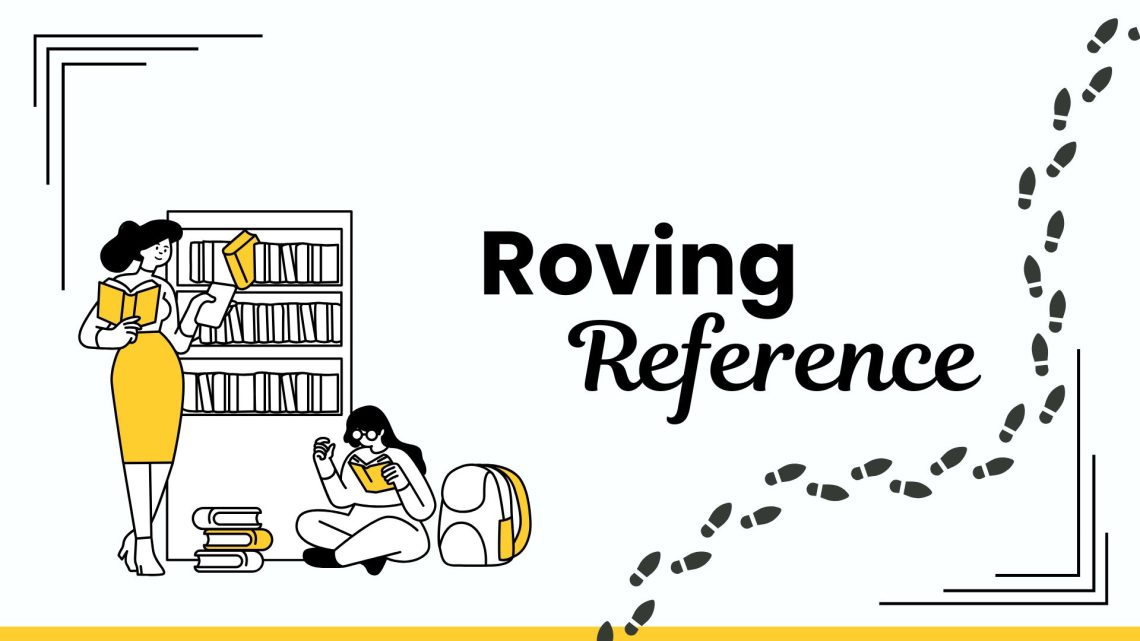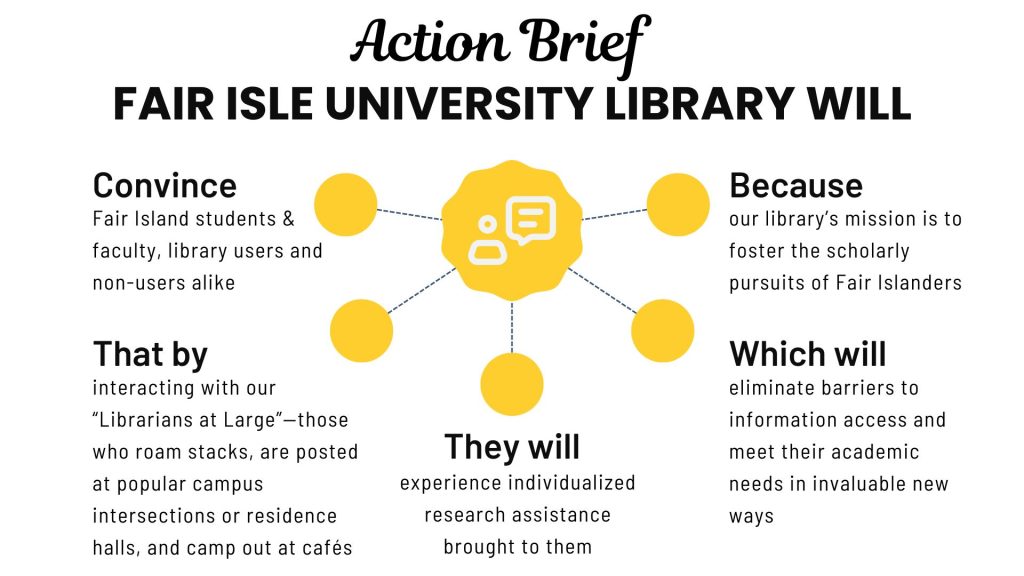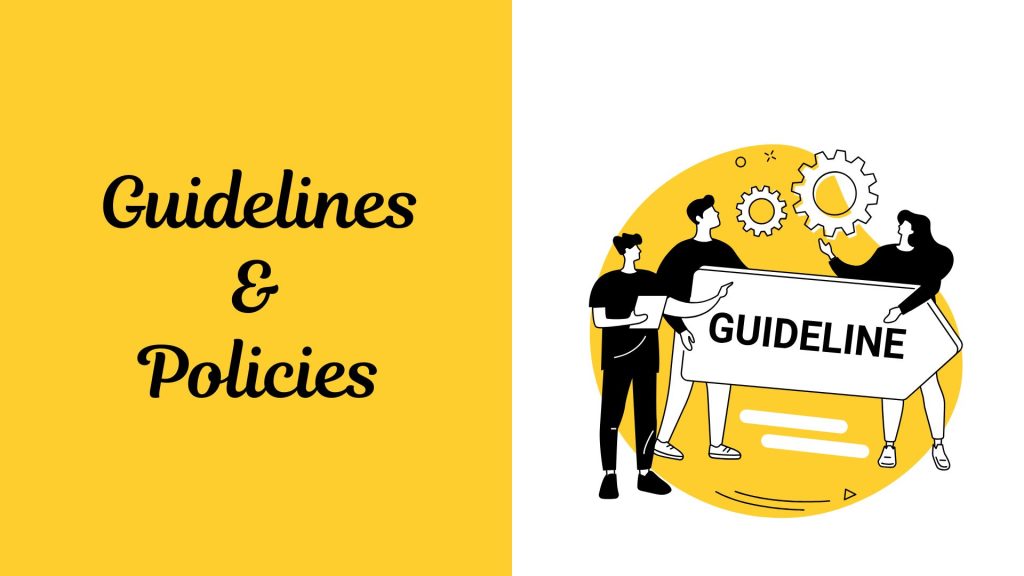
Innovation Strategy & Roadmap: Librarians at Large
For this assignment, I will be using a fictional academic library to implement my emerging trend.

This concept goes by many names: Roving Reference, Roaming Reference, Librarian on the Loose, Librarians in the Wild, Your Library, and more. No matter what you call it (“a rose by any other name,” and all), the service refers to a non-traditional, proactive reference method that leaves the desk–and sometimes even the library itself–behind, using technology to mobilize reference resources and meet patrons where they are. This is especially important in a time when traditional, passive reference interactions are on the decline (Dempsey, 2011; McCabe & MacDonald, 2011; Bremer, 2016). We plan to invite users to participate in shaping the service over time through user surveys, polls, and in-person feedback (Casey & Savastinuk, 2007). By adopting this initiative, our library will be one step closer to reaching “all users, not just those who come through our doors” (Stephens, 2016). These efforts will also further our library mission to support the academic pursuits of Fair Islanders via research assistance, facilitating access to information resources, and providing instruction on their use.


This service will primarily help Fair Isle University’s 5,000 graduate and undergraduate students, whose research endeavors will be enhanced by increased engagement with reference librarians and other library services. The library itself will also benefit from increased visibility and usage of resources, and our larger institution will see improved academic performance. The individual librarians “at large” will come to better know the campus community by venturing beyond library walls and conversing with students, faculty, and other staff. Overall, a stronger connection between library and patrons will be forged, and this connection may even serve to further academic research as whole.

There is ample precedent and justification behind this initiative. The University of Minnesota, Morris (UMM) Briggs Library, the University of Huddersfield Library, the Geoffrey R. Weller Library (University of Northern British Columbia), the Evelyn S. Field Library (Raritan Valley Community College), and Bass Library (Yale) are among those institutions who have introduced a roaming reference service of some kind. Across the board, these libraries have seen a rise in reference interactions as a result (Bremer, 2016; Sharman, 2014; McCabe & MacDonald, 2011; Dempsey, 2010; Blanchat & Sider, 2020).

Staff who participate in the Librarians at Large services will accept all library- and information-related questions. Referrals to internal or external librarians for additional help should be made where appropriate. The proposed schedule and details are as follows:
- First-year residence halls:
- Once per month during school year; one additional visit during midterms and finals weeks
- 180 minute commitment
- Student wellness resources and food/coffee will be provided during exam week visits; students do not need to ask a reference question to gain access to these items
- Those who do ask a reference question and fill out the survey afterward will be offered a piece of candy
- On-campus café:
- Once per week during school year
- 90 minute commitment
- Students who fill out the survey afterward will be entered into a monthly raffle for a $10 gift card to the café
- High-activity campus intersections:
- Once per week during school year
- 60 minute commitment
- Students who ask reference questions will be offered a piece of candy while supplies last
- Those who fill out the survey afterward will be entered into the monthly raffle for the café gift cards
- Roaming the stacks:
- Three times per day, no more than once per day by any individual staff member
- Staff who are scheduled to visit a residence hall, café, or intersection may also opt out of stacks duty on that day
- 90 minute commitment
- Staff will take turns on stacks shifts, with those who remain in their offices covering virtual or other in-person reference questions during those periods
- Librarians who are on a roaming shift are to change their virtual status to “Away,” and no virtual reference questions will be fielded to them during that time
- Three times per day, no more than once per day by any individual staff member
For each category of roaming reference, librarians will use campus WiFi to conduct research on iPads. Equipment will also include wireless keyboards. The screen size is intended to aid visibility and simulate computer research many students conduct, while the keyboard will improve research efficiency when desired. Staff who are positioned at high-traffic campus intersections and residence halls are to bring a collapsible table and chair for setup.
Following any interaction with students or faculty, staff are to record the type of question (research, directional, or technology-related) and location in a Google Form. This data will be compiled each semester for review.

The project will officially launch in Fall 2025 and is intended to continue each semester. Participation in this initiative is meant to be voluntary; however, if fewer than three librarians volunteer by May 1st, 2025, the Head of Reference will select candidates based on perceived suitability.
iPad equipment will be purchased in May of 2025. Librarians will begin training in June (for more details on training, see “Staff Training”). Edible prizes and incentives (i.e., candy) will be purchased on an ongoing basis to maintain freshness. Marketing will begin 3 weeks before the fall semester starts; physical materials, such as flyers, will remain in the library year-round and for as long as possible in other campus spaces.

Librarians at Large will be promoted in-person and online via word-of-mouth, library social media posts, flyers, and the campus newsletter. The library will also coordinate with faculty and campus departments, such as Academic Success, to get the information to students. See example flyer below.


All staff will be informed of the project via a weekly email update.
Circulation Desk: Starting in April of 2025, student employees who plan to continue working at the circulation desk in the fall will be more thoroughly trained by their supervisor on how to answer directional questions (e.g., where the printer is located, or where a particular book can be found). This training will consist of in-person explanations and demonstrations in a group setting (other Circulation staff will cover the desk during this time). Though the project will not launch immediately, this early instruction is meant to allow students to hone their skills in the following months. All new students who start in the fall will also receive training. The intent is to utilize all available staff to answer non-reference questions, freeing up our reference staff for more uninterrupted research and roaming periods.
Librarians who will be “at large”: Starting in June of 2025, participating staff will begin a self-paced, online training course on roaming reference. This 3-hour course will be created by the collaborative efforts of our Reference Coordinator and Outreach librarian; it will cover topics like friendliness/approachability and how to use the iPads (including connecting to WiFi, accessing library databases, exporting results, etc.). In order to practice with the technology, librarians will also begin answering simulated reference questions on the iPads throughout the summer. They will move on to actual patron questions once they establish adequacy.

As aforementioned, staff will record all reference interactions–roaming and desk-based–in a Google Form. Here, they will document the type of question (research, directional, or technology-related) and their location. At the end of each semester, these statistics will be analyzed and compared to previous years. If implementing a roaming reference service increases the number of questions by at least 100 in the first semester, the project will be considered a success. If, however, there is no significant change in reference numbers, the locations and strategy of this proactive approach will be reimagined.
Also mentioned were student user surveys. These surveys will be used to alter the design of the initiative over time based on student feedback. These will be reviewed twice a semester, and any feasible changes will be introduced as soon as possible–we want students to feel that they can help shape the services that are built for them.
If the Librarians at Large project is a success, we will attempt to expand the number of dorm and residence hall visits. We might also increase the hours among the stacks, or even the number of staff who roam.
References
Blanchat, K., & Sider, L. (2020). Reference with a gimmick: A pilot program to promote library services. Marketing Libraries Journal, 4(1), 33–47. https://journal.marketinglibraries.org/april2020/04_MLJv4i1_Column_Trenches_Blanchat_Sider.pdf
Bremer, P. (2016). Librarian on the loose: A roving reference desk at a small liberal arts college. The Reference Librarian, 58(1), 106–110. https://doi.org/10.1080/02763877.2016.1199006
Casey, M. E., & Savastinuk, L. C. (2007). Library 2.0: A guide to participatory library service. Information Today, Inc.
Del Bosque, D., & Chapman, K. (2007). Your place or mine? Face-to-face reference services across campus. New Library World, 108(5/6), 247–262. https://doi.org/10.1108/03074800710748803
Dempsey, M. (2011). Blending the trends: A holistic approach to reference services. Public Services Quarterly, 7(1–2), 3–17. https://doi.org/10.1080/15228959.2011.572769
McCabe, K. M., & MacDonald, J. R. W. (2011). Roaming reference: Reinvigorating reference through point of need service. Partnership, 6(2), 1-. https://doi.org/10.21083/partnership.v6i2.1496
Sharman, A. (2014). Roving librarian: The suitability of tablets in providing personalized help outside of the traditional library. The New Review of Academic Librarianship, 20(2), 185–203. https://doi.org/10.1080/13614533.2014.914959
Stephens, M. (2016). The heart of librarianship: Attentive, positive, and purposeful change. ALA Editions.


